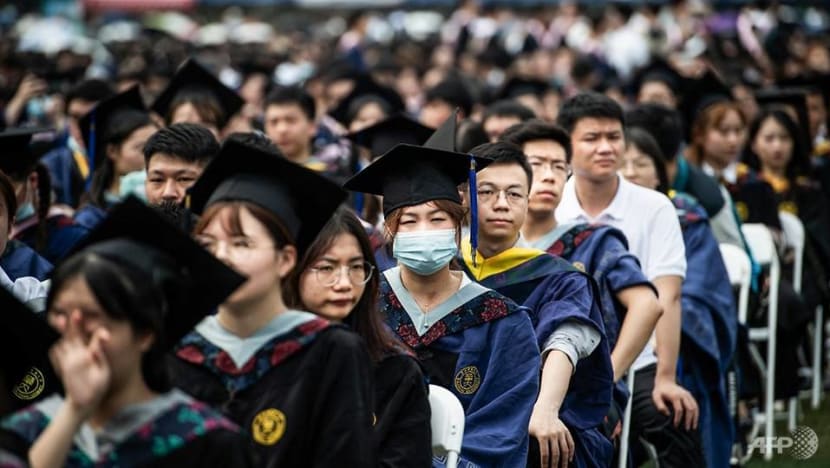Commentary: China faces an oversupply of university grads and an undersupply of skilled workers
Chinese employers are enticed by the abundant supply of university-educated jobseekers and are not incentivised to increase salaries for vocational graduates – leading to an endless loop of degree depreciation and lower rates of vocational enrolment, say economists.

ZHENJIANG, China: Deciding whether to pursue academic or vocational education is not easy. Education costs time and money, and is expected to deliver higher economic returns than the price paid to acquire it.
This challenge is exacerbated by global uncertainty, job market mismatch and overeducation. In China, many students choose to go to a vocational school because of their low academic performance or their rural-to-urban migration status.
But data indicates there is still an oversupply of university graduates and an undersupply of skilled workers. China’s youth must grapple with the reality that education no longer guarantees prosperity.
Following the global trend of rapidly increasing student enrolment in higher education, the number of university enrolments and graduates has increased dramatically in China.
The increase has been so substantial that data from 2015 to 2017 showed that the proportion of university graduates aged 24 to 35 outweighed the share of lower secondary graduates – a clear sign of the consequences of rapid higher education growth.
Mass education can compromise the quality of education and may challenge socio-economic development if growing student enrolments are not accompanied by proportionate increases in human, financial and physical support.
The problem is further magnified when university graduates believe that higher education is elite education and refrain from doing blue-collar jobs that offer the most vibrant opportunities in China.
STIGMA OF VOCATIONAL EDUCATION
The job market situation facing young people in China is challenged by the undersupply of skilled workers. Data from the last decade shows that, across all working aged people, around 30 per cent completed lower secondary education, 14 per cent completed academic upper secondary education and only 9 per cent completed vocational upper secondary education.

There has been a significant shift from an economy dominated by lower-educated workers to higher-educated ones, reflecting an overall improvement in the quality of labour supply.
There has also been an increase in vocational upper secondary graduates and vocational university graduates in the younger generations. But the increase is more a result of government policy that aims to balance vocational enrolments and academic enrolments nationwide than a result of individual decisions.
Students are simply reluctant to choose the vocational track. China has a long-standing culture of degrading vocational graduates and discouraging parents from sending their children to vocational institutes.
In the job market, employers are enticed by the abundant supply of highly qualified university candidates and are not incentivised to increase salaries for vocational graduates of any level.
Despite the reluctance of employers, the undersupply of skilled workers coupled with the oversupply of university graduates has shrunk the wage differences between vocational upper secondary graduates and university graduates.
WORSENING MISMATCH IN JOB MARKET
The oversupply of university graduates and the undersupply of skilled workers have both worsened the job market’s mismatch problem. Highly qualified individuals have to match downward to low-skilled jobs and snatch opportunities from less competitive vocational graduates.
This decreases the attractiveness of vocational education and further depreciates the value of degrees as more students turn to academic education.
The gender wage gap is prevalent across vocational and academic graduates. At the upper secondary and tertiary level, men are consistently paid 11 to 14 per cent more than women. The gender wage gap is persistent across multiple dimensions.
Within the same gender, returns to academic education at the tertiary level are more than 20 per cent higher than returns to vocational education. Yet returns to academic education at the upper secondary level are similar to returns to vocational education at the same level.
Tailored policies are needed to stop the gender wage gap facing married females from widening further – especially given China’s plummeting birth rate. Without supportive policies for married females in the job market, the decreasing birth rate has no chance of bouncing back in the near future.
The endless loop of degree depreciation and lower rates of vocational education highlights the importance of changing the traditional perception of vocational education as an inferior option. The government must advertise vocational education in a more positive light.
The undersupply of skilled workers calls for policies that can improve the overall quality of vocational education and increase the number of students who opt for it.
Francesco Pastore is Associate Professor of Economics at the University of Campania Luigi Vanvitelli. Jie Chen is Lecturer of Economics at Jiangsu University. This commentary first appeared on East Asia Forum.
















